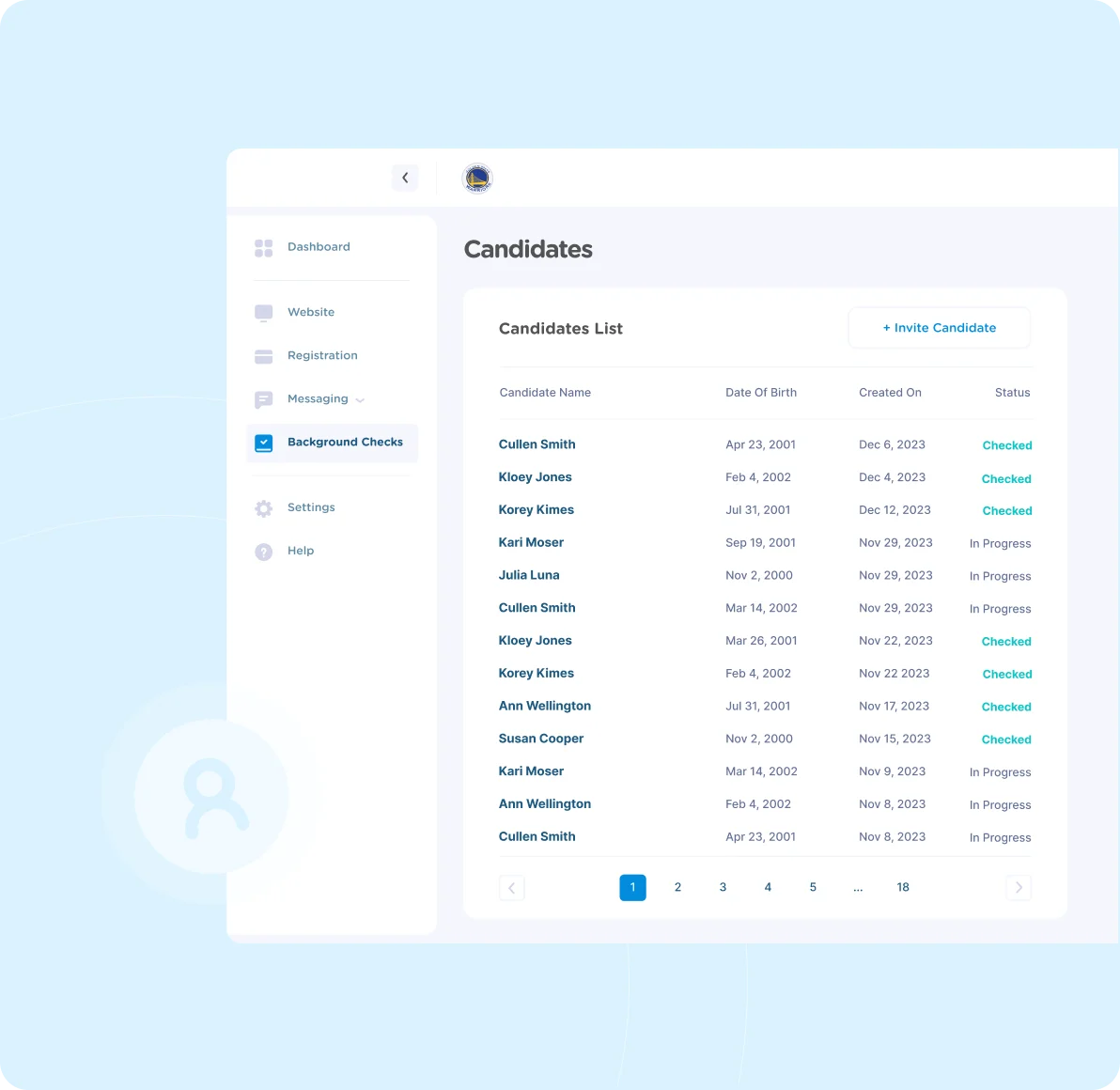
Table of Contents
Starting a youth sports league is hard for a number of reasons. Access to facilities, inconsistent community support, and lack of sportsmanship play a part in a decline in participation.
Want to start a youth sports team or organization, but don’t know where to start? Ahead, you’ll learn the fundamentals of starting a sports club with tips to grow and succeed.
How to start a youth sports league
- Plan costs
- Find a facility
- Find volunteers
- Raise money
- Promote the league and register participants
- Involve the community
- Prioritize safety
- Build an online store
- Throw a launch party

1. Plan costs
Starting a sports league can be expensive. The good news is that you just need to come close to breaking even as a non-profit sports league.
Before you open registration, create a budget for the sports league so you can decide how much to charge each player. You should consider the average costs of youth sports as well!
There’s a long list of potential expenses you should be aware of in your first season, including:
- Equipment
- Uniforms
- Field or Facility Rentals
- Insurance
- Website and other management software
- Referees, umpires, or other non-volunteer staff
Also, don’t forget to create a plan to collect donations, apply for grants, and find sponsors for your organization. Additional funding can help offset all of your expenses, especially in the first few years.
2. Find a facility
At least 6 months before your first event you need to ensure you secure a facility. Here are a few places you can go to try to track down a facility:
- Local school districts
- Parks & rec departments
- YMCA or other local sports non-profits
- For-profit sports facilities or recreation centers
Reach out to all of the facilities in your area to compare prices and availability. In your first season, make sure not to lock yourself into any major contracts or commitments. You should be able to find a facility that has plenty of room for a new league in your community. You may even hold free practices at a local park if you have a small program.
Looking to create your first schedule? Check out How to Create a Sports Schedule to get started!
3. Find volunteers
Volunteers are the backbone of any successful youth sports program. You’ll need dozens of dedicated volunteers to coach, manage registration, run your social media, work fundraisers, and more.
Here are some key steps to get volunteers:
- Identify all of the roles you’ll need in the first year. These might include coaching, fundraising, facility maintenance, equipment management, and scheduling.
- Reach out to parents and other members of the community with yard signs, social media, and email. You can even drop off fliers in mailboxes.
- Provide clear descriptions of the roles, responsibilities, and hours required for each volunteer. Make sure you’re offering a wide variety of roles so that busy parents are still able to contribute.
- Thank your volunteers! You should recognize each volunteer on your website, social media, and other promotional materials. People love to be rewarded for their hard work, even if it’s just a digital mention.
Similarly, background checks are also important when it comes to keeping your league a safe and welcoming space. From coaches to officials to volunteers, thorough background checks before each season help clear that all the adults involved are not potential risks to youth players.
If you've never required background checks at your organization before, you should develop a background check policy in your next offseason.

Running background checks on volunteers and coaches before your season helps keep your players safe.
4. Raise money
Generating long-term community support also requires a year-round commitment from your board. You should develop a plan to attract new sponsors, apply for grants, and recruit new volunteers in your offseason.
You can also raise significant funds by using online tools to collect donations and writing a detailed donation letter to send out to community members.
5. Promote the league and register participants
Use a league website and online registration software
Parents expect that your organization is going to provide a quick and easy registration experience, communicate effectively throughout the year, and provide relevant information like league schedules online.
Creating a website for your organization is the first step to effectively promoting your organization online. The website can be the hub for all the information about your organization, registering players, and managing payments.
Don't have a website yet? Learn some quick tips to build your site in this video.
Take advantage of social media
You also need to make sure your organization has social media accounts to help promote the organization. You can appoint a person on your board to be in charge of social media and to manage all of the accounts.
If you don't have social media accounts yet, you can start small by creating a Facebook page.
6. Involve the local community
Meeting parent expectations is one of the most difficult parts of running a sports organization.
You can start by hosting a meeting with the players’ parents at the start of the season. Use this meeting to discuss guidelines for playing times and let parents know what to expect up front: walk through policies and set clear expectations so parents are well-informed.
This is also a good time to review your organization's coaching philosophy. Many misunderstandings and unrealistic expectations can be avoided with a little clear communication beforehand. When parents understand the reasoning behind your practice and game day plans, they are more likely to support your decisions.
A paper trail is always good—creating codes of conduct for players and parents is a great way to support the points you discuss at this meeting. Enforcing a code of conduct is also a great way to get your expectations across to players and coaches.
Using communication software can help take your organization to the next level. Parents expect to be able to receive important updates via text or email. Don’t make them search for information and always keep parents, volunteers, and community members informed!

7. Prioritize safety
Safety is always a concern, especially for young players. Concerns about safety can often be an obstacle to youth sports league growth. Make safety a top priority at all times, from pre-season to closing events.
You can take steps to ensure your players' safety, and parents will appreciate you doing so. For example, creating awareness around concussion-related injuries is critically important and should always be encouraged. Talk with parents and your community to ensure everyone is informed about injuries and risks.
Also, make sure to constantly update and upgrade your equipment. Equipment that is out of date can be dangerous for players. Equipment is expensive, and a good service plan for certain items can assist, but make sure to never, ever cut corners on new equipment when you need it.
🧠 Learn: Youth Sports Participation Trends
8. Build an online store
You should have an online apparel store that is available year-round. Getting community members to wear your team gear will increase support and provide fundraising opportunities.
Depending on your league's needs, you can set up a store run completely online. You don't have to worry about collecting payments or managing inventory - just set up the store, post the link on your website and social media, and start selling gear!
9. Throw a launch party!
Growing your league is a breeze when you have community support. Start your season with a party (say, an opening ceremony or preseason cookout) and invite the whole community to the event - players, parents, coaches, sponsors, and local businesses.
Send out press releases, advertise on social media, and contact the local newspaper to help spread the word. An exciting event before the season starts will generate interest from potential sponsors and build camaraderie for the entire league.
How do sports leagues work?
A sports league typically operates year-round to support a sport (or multiple sports) in a community. You can start a youth league for any sport, like:
- Flag football
- Softball
- Lacrosse
- Football
- Basketball
- Football
- Soccer
- Baseball
- Volleyball
Generally there are multiple divisions for age groups, gender, or skill level. For example, if you run a basketball league, you’d divide it into groups like 8&under, 10&under, 12&under, and so on. Many organizations also offer recreational co-ed leagues, especially for younger athletes.
Here’s how a sports league typically works:
- Registration is typically open 6 months or so before the season starts, and ends about a month before the season begins.
- After registration, teams and divisions are formed and "you made the team" letters are sent out. Schedules are also created for practices and games. For larger leagues, the organization can consolidate everything into one youth sports calendar.
- Generally a sports season will have at least a few weeks of practice before games begin. The game schedule will typically last 3-6 months depending on the sport and the level of competition.
- At the end of the season there are typically post-season tournaments, banquets, or end-of-season parties.
- During the offseason most organizations plan for the next season and have offseason events including fundraisers, camps, board meetings, and more.
How sports leagues make money
The primary money maker for sports leagues is registration fees paid by each player to participate. Most sports organizations also use a variety of other revenue sources, like sports sponsorships and fundraisers.
Learn more about ways to make money for your organization:
Start your youth sports organization today
Big change won't happen overnight. Initially, you can start a nonprofit sports team grow into a club or league after a few seasons.
You should start by creating a positive experience not only for players, but for parents as well. Managing parents starts by setting expectations up front and enforcing a code of conduct.
Prioritizing safety measures to keep kids protected on the field helps increase trust with parents. Make sure that coaches and parents are aware of safety guidelines at your league and continue to collect feedback on policies after your season is over.
Finally, make sure to invest in modern technology to make marketing and managing your league easy each season!